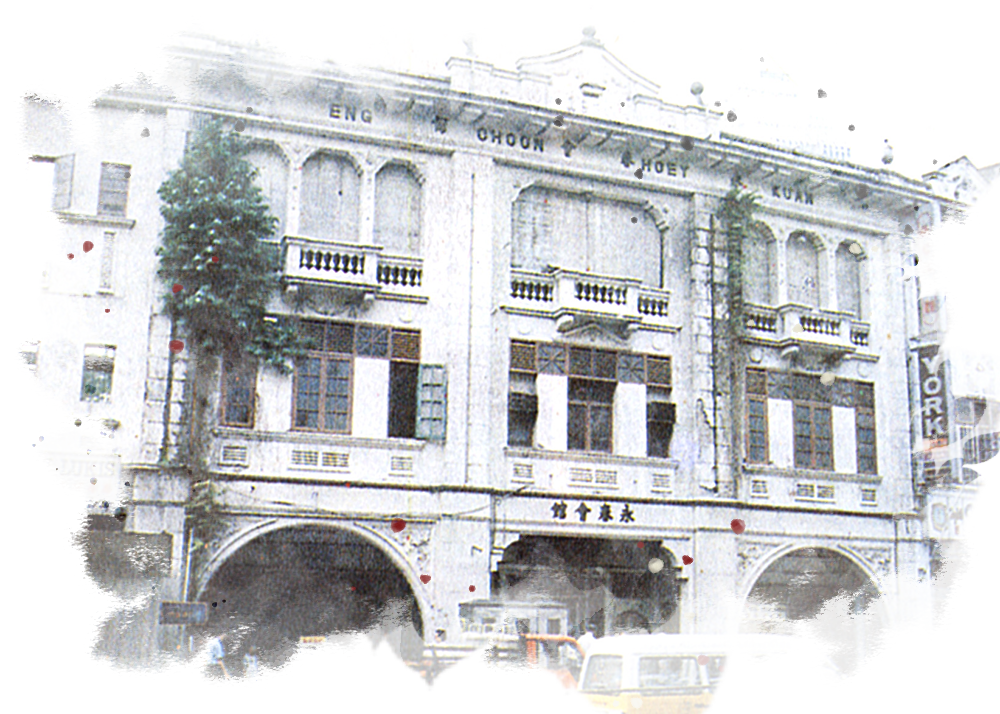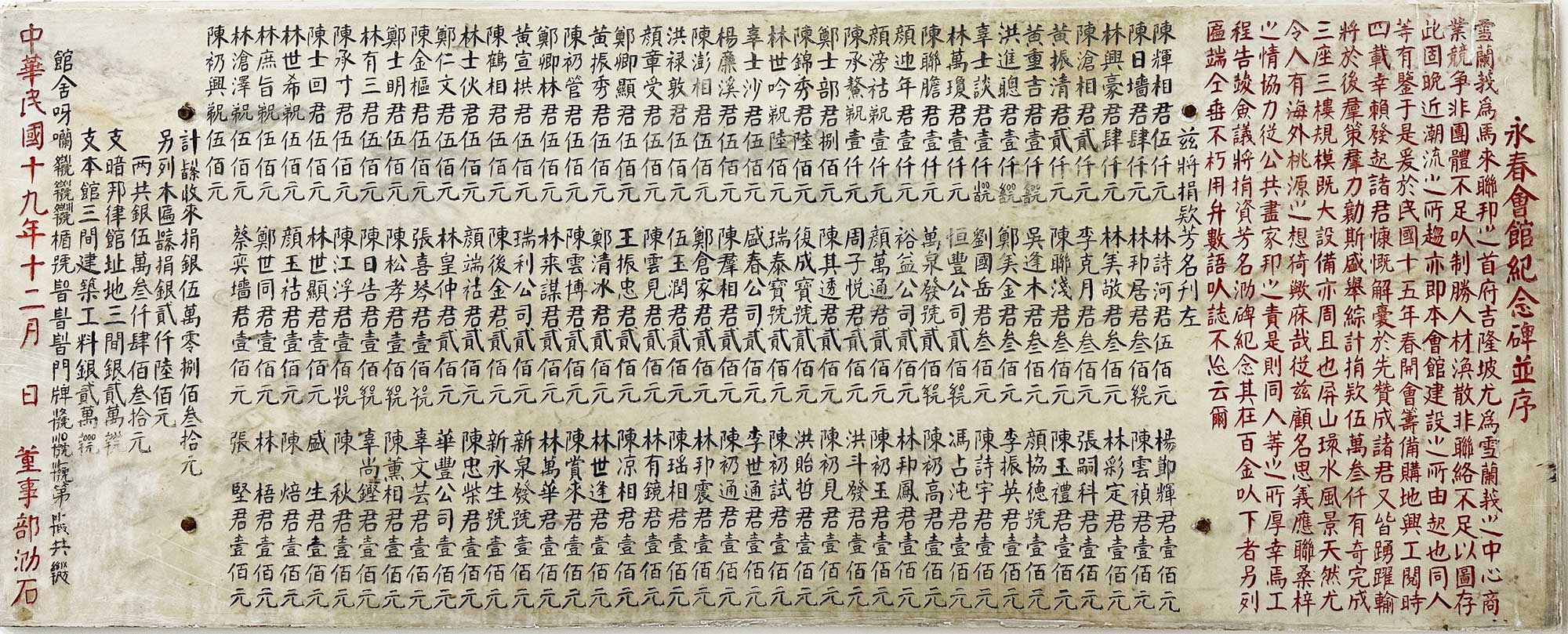The Engchoon Kuala Lumpur History Gallery






Engchoon Community Prior to
Malaya's Independencen
Before World War II, the Engchoon people still made up only a minority within the Fujian community. According to burial receipt records from the Kuala Lumpur Hokkien Cemetery, kept by the Selangor Hokkien Association from 1930 to 1941, the majority of those buried in the Hokkien Cemetery during this period were of Anxi origin, accounting for 42% of the total. People from Nan’an made up the second largest group, comprising 22%, while those from Engchoon only represented 16%. After the establishment of the Kuala Lumpur Engchoon Association in 1924, the leadership of the Selangor Hokkien Association was mainly composed of leaders from the Engchoon Association. Throughout the more than one hundred years of the Selangor Hokkien Association’s history, the Engchoon people have always played a pivotal role.
The Formation of
the Engchoon Community
in Kuala Lumpur
Selangor was developed relatively late, and Kuala Lumpur was developed even later due to the discovery of tin mines. Therefore, many of the pioneers among Kuala Lumpur’s Chinese community migrated from other regions. For example, the earliest Huizhou people who came to Kuala Lumpur to mine tin were originally miners from the Lukut mining area. Additionally, some migrated from mining areas in Perak. The Dapu people migrated from Kajang. Furthermore, the Cantonese people began arriving in Kuala Lumpur after large mining companies established operations there. The Engchoon people mostly migrated from coastal areas of Selangor. Some also relocated from the Straits Settlements of Malacca and Singapore, or came directly from their ancestral homes in China.
According to records from the Kuala Lumpur Engchoon Association, by the late 19th century, the Engchoon people had established themselves in Kuala Lumpur, primarily concentrated in the Kampung Baru area around Jalan Hale (now Jalan Raja Abdullah), Jalan Kamunting, Jalan Yap Ah Shak, and Jalan Doraisamy. At that time, there were more than a hundred Engchoon households living there. After the establishment of the Lai Ming Girls’ School on Jalan Ampang, its leadership was mainly composed of Engchoon people, primarily because the school’s original location was in Kampung Baru, where many Engchoon children studied. Of the seven chairmen since the school’s founding in 1929, five were Engchoon people, and the majority of board members were also Engchoon people.
By the early 1920s, many Engchoon people in Kuala Lumpur were engaged in commercial activities, such as rubber, tin mining, groceries, textiles, and real estate, with a focus on textiles and rubber. Notable individuals at the time included Chen Riqiang, Yan Panghu, Chen Huixiang, Hong Jincong, Chen Pengxiang, Lin Bangling, Huang Zhongji, Huang Zhenxiu, Lin Shiyin, Chen Yunzhen, Lin Yousan, and Chen Cangxiang, among others. Some historical documents indicate that some Engchoon people in Kuala Lumpur migrated from other places, including Bentong in Pahang, Broga in Negeri Sembilan, and various places within Selangor such as Kuala Kubu Bharu, Semenyih, and Klang, all of which have deep historical ties with the Engchoon community in Kuala Lumpur.
The Engchoon pioneers from Broga who made significant contributions to the Kuala Lumpur Engchoon Association
Source: Provided by Kuala Lumpur Eng Choon Hoey Kuan

杨廉溪

颜章受

郑乡显
The Historical Significance of
the Establishment of
the Kuala Lumpur Engchoon Association
In 1880, the British colonial government moved the capital of Selangor from Klang to Kuala Lumpur, leading to a rapid expansion of commercial activities in the city. This accelerated the migration of the Hokkien dialect group, known for their business acumen, to Kuala Lumpur. From 1883 to 1895, the Selangor government made extensive efforts to develop transportation. In 1886, the railway from Kuala Lumpur to Klang was officially opened. Railways connecting Kuala Lumpur to Rawang, Kuala Kubu Bharu, and Sungei Besi were gradually completed, boosting commercial activities in Selangor. In 1885, the Hokkiens in Kuala Lumpur established the Selangor Hokkien Association, further encouraging Hokkiens from other parts of Selangor to migrate to Kuala Lumpur.
The establishment dates of various Chinese clan associations in Kuala Lumpur indicate the timeline of different dialect groups and subgroups settling in the city. In the late 19th century, Kuala Lumpur was still predominantly populated by Hakka and Cantonese people. This necessitated other dialect groups to form larger communities through broader dialect connections to establish a foothold in Kuala Lumpur.
The Selangor Hokkien Association was established in 1885, with its headquarters initially located at No. 7 High Street. Later, a new building was erected at No. 41 Klyne Street. The history of the Selangor Hokkien Association records: “The Selangor Hokkien Association was established as early as 1885. Initially named the Hokkien Company, it was located at No. 7 High Street, Kuala Lumpur. The early pioneers hired teachers and set up a school to impart Chinese culture to the children of the community, and the building also served as a residence for the community members. As more members migrated, the community leaders collectively contributed land at No. 41 Klyne Street for a new building. The temple inside enshrined the deity Fazhugong, attracting numerous devotees.” Fazhugong is the most common deity worshipped in Engchoon, indicating that a significant proportion of the Hokkien subgroups within the association were from Engchoon.
Due to the concentrated settlement and successful business ventures of the Engchoon people, as well as their close ties with Engchoon communities outside Kuala Lumpur, there was a strong sense that without a formal organization, it would be difficult to maintain contact and unity among their fellow villagers. This would hinder efforts to solidify their existing business foundations and compete with other dialect groups. Initiated by leaders such as Chen Riqiang, Chen Pengxiang, Yan Panghu, Huang Zhongji, Hong Jincong, Chen Renyuan, Lin Bangling, Huang Zhenxiu, Lin Shiyin, Zheng Qingxian, Yang Lianxi, Zhang Xiqin, and others, the Kuala Lumpur Engchoon Association was finally established in 1924. It became the first geographically-based association among the Hokkien dialect groups in Kuala Lumpur.
It is noteworthy that many of these leaders of the Engchoon community were already successful businessmen in Kuala Lumpur at that time, possessing considerable economic strength. These pioneers were primarily involved in rubber trading, large estate ownership, cloth business, and some were also engaged in tin mining. Industrialist Huang Zhongji also began to rise in prominence in the Selangor region.
In its early days, the association temporarily used the second floor of Chen Riqiang’s Quan Feng Company on Fujian Street as its makeshift office. They immediately convened a meeting with fellow townsmen in Kuala Lumpur to discuss the establishment of the Engchoon Association. With strong support from the community, the Preparatory Committee was officially established on September 27, 1924. In spring 1925, the committee began fundraising for the construction of a permanent clubhouse. Within a few months, 112 donors contributed more than 100 dollars each, totaling 50,830 dollars in pledged funds. Including donations under 100 dollars, the total raised exceeded 53,000 dollars. In early March 1926, the Kuala Lumpur Engchoon Association held a meeting and decided to purchase three plots of land along the Klang River for building purposes.
On December 2, 1928, at 2:00 PM, the annual general meeting of the Kuala Lumpur Engchoon Association convened to elect the first board of directors for the year 1929 according to the association’s constitution. The key responsibilities of the board members were formally assigned as follows:
Chen Riqiang
Hong Jincong
Chen Pengxiang
Huang Zhongji
Yan Panghu
Chen Renyuan
Huang Zhenxiu
Yang Lianxi
Lin Shiyin
Chen Yunzhen
Lin Bangling
Chen Yaoxiang
The exterior appearance of the Kuala Lumpur Engchoon Association upon its completion in 1931
Source: Provided by Kuala Lumpur Eng Choon Hoey Kuan

In December 1930, the Kuala Lumpur Engchoon Association was officially completed, and a grand opening ceremony was held in April 1931. Except for a period of interruption during the Japanese occupation of Malaya from 1941 to 1945, the leadership of the Kuala Lumpur Engchoon Association has consistently been a crucial supporting force in various constructions within the Kuala Lumpur Chinese community. They not only held leadership positions in the Hokkien Association but also actively participated in the Selangor Assembly Hall and the Kuala Lumpur and Selangor Chinese Chamber of Commerce. In 1957, they led Engchoon associations nationwide to establish the Federation of Malaya Engchoon Associations, becoming one of the most dynamic organizations among Engchoon associations across the country.
In the Dr. Tan Sri Lim Wee Chai Auditorium at the Kuala Lumpur Engchoon Association, the commemorative inscription from the completion of the association in 1930 is still preserved. In addition to listing the names of donors and their contributions during the construction, the inscription includes an important preface detailing the founding of the Engchoon Association in Kuala Lumpur. It mentions, “Kuala Lumpur, being the heart of Selangor, faces fierce commercial competition where individual efforts alone are insufficient for success. Dispersed talents require connectivity for survival, aligning with prevailing trends and thus motivating the establishment of this association.” This underscores the strong community spirit in Kuala Lumpur at the time, compelling the Engchoon community to consolidate their strength to navigate the competitive environment.
The list of donors and donation amounts during the construction of the Kuala Lumpur Engchoon Association
Source: Provided by Kuala Lumpur Eng Choon Hoey Kuan

The Inauguration Ceremony of the Kuala Lumpur Engchoon Association
Source: Provided by Kuala Lumpur Eng Choon Hoey Kuan

The membership registry of the Kuala Lumpur Engchoon Association has preserved the basic information of its members
Source: Provided by Kuala Lumpur Eng Choon Hoey Kuan

The meeting minutes of the Kuala Lumpur Engchoon Association have preserved the history of the Engchoon people
Source: Provided by Kuala Lumpur Eng Choon Hoey Kuan


